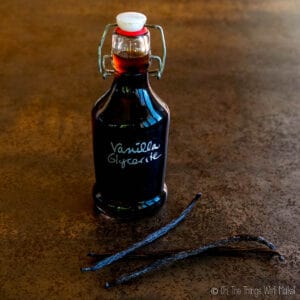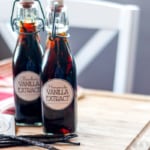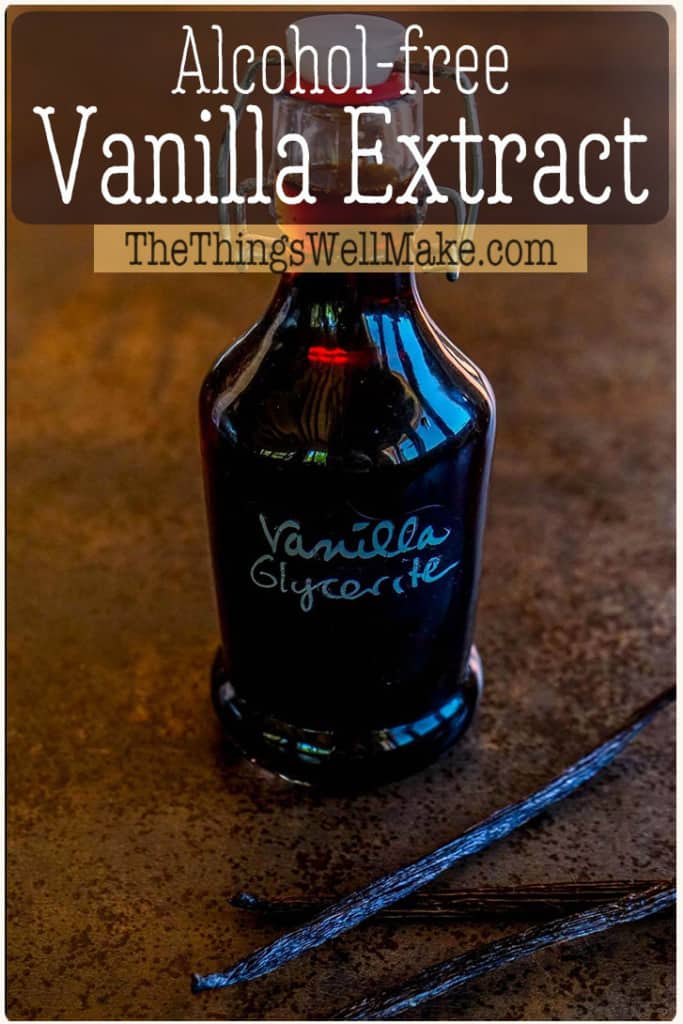Avoiding alcohol, but want an easy way to use pure vanilla in recipes? This non-alcoholic vanilla extract is simple to make and is the perfect alternative to alcohol-based extracts.

Several years ago, I shared a recipe for making homemade vanilla extract using vanilla beans and alcohol. Alcohol is perfect for making vanilla extract because it quickly and thoroughly extracts the vanilla color and flavor. It’s simple to make and is the perfect way to add a touch of vanilla flavor to your recipes.
Over the years, though, I’ve received comments from people looking to make an alcohol-free version. Either they can’t legally buy alcohol in their country or they choose to avoid alcohol for religious or health reasons. It’s very difficult to find a pure, natural vanilla flavoring that doesn’t use alcohol.
Luckily, for those cases, there is another option…
Glycerin extractions
Just like alcohol, vegetable glycerin can be used to extract the flavor, color, and aroma of vanilla.
Glycerin is what is called a sugar alcohol. While it does contain both sugar and alcohol groups, it does not contain ethanol, the alcohol that can make you drunk. That makes it safe for alcoholics and those that avoid ethanol alcohol.
Another great thing about glycerin is that like alcohol, glycerin has preserving qualities. When used at over 55%, the resulting product is generally self-preserving.
Those two qualities make glycerin an ideal alternative to grain alcohols for making a vanilla extract that can be used for cooking and baking and kept long-term.
If we must be technical, a true “extract” has at least 35% alcohol. This is actually a vanilla glycerite, or a glycerin tincture.
Ingredients
To make a glycerin-based vanilla extract, you only really need 2 ingredients, glycerin, and vanilla beans. Because glycerin is a bit sweet and syrupy, you can dilute the glycerin slightly with some water.
If you decide to dilute the glycerin with water, keep in mind that adding too much water can make it so that the mixture becomes prone to microbial growth and could go bad.
I don’t recommend using much more than 1 part water to 3 parts glycerin. By keeping the glycerin concentration high, you ensure a long-lasting vanilla glycerite.
I’ve had my bottle of homemade vanilla glycerite for several years now and it hasn’t shown any signs of rancidity yet.

Glycerin
Vegetable glycerin is often used in cosmetics as a humectant. (It helps draw moisture into your skin and hair.) For this recipe, though, you’ll want to ensure that you choose a food-grade glycerin. If you are avoiding GMO’s, you should also choose organic glycerin or glycerin that is certified as GMO free.
Vanilla Beans
Over the last few years, the price of vanilla beans has risen considerably. Vanilla beans come from an orchid which can be difficult to grow. Most vanilla beans come from Madagascar which has suffered lost crops from bad weather. For many years, artificial vanilla took over the market, but as more and more people are looking to live a more natural lifestyle, the demand for vanilla has increased.
To save money, choose extract-grade vanilla beans for this recipe. They are a bit smaller in size and often drier. As we’ll be extracting the flavor in a tincture, we don’t need large, plump vanilla beans.
You may find several types of vanilla beans when looking to buy them. Those from Madagascar (also called bourbon vanilla) are the most common and have a more classic vanilla flavor. The Tahitian variety is said to have a more exotic tropical flavor. (I’ve always used the Madagascan vanilla, so I can’t comment otherwise.)
Procedure
Making it is as simple as slicing the vanilla beans lengthwise and placing them in the glycerin (or glycerin and water) for several weeks. By slicing the vanilla beans lengthwise, you expose the tiny seeds inside.
Ideally, for the first several weeks, you should periodically shake the bottle or at least flip it over to allow the vanilla to infuse throughout the mixture. With time, the glycerin should take on a stronger vanilla flavor.
Keep in mind that glycerin doesn’t extract as quickly or as thoroughly as alcohol. So, it normally will take 2-3 months to get a decent strength glycerite.
Using the glycerite
This vanilla glycerite can be used in place of vanilla extract in recipes. Because the flavor may be slightly more subtle, you may find that you may need to use more of it than you would an alcohol-based vanilla extract to get the same strength flavor.
Because glycerin is sweet (around 75% the sweetness of sucrose), you may also find that you want to use slightly less sugar in the recipe. This, of course, will depend on the recipe you are making.
As you use the extract, you can refill the bottle with more glycerin to continue to get more from the same vanilla beans.

Alcohol Free Pure Vanilla Extract
Ingredients
- 16 fluid ounces glycerin food grade
- 10 vanilla beans
Instructions
- Cut the vanilla beans lengthwise to expose the inner seeds.
- Place the sliced beans into a glass container.Use at least 5 vanilla beans for every 8 fluid ounces (240ml) of glycerin.
- Add the glycerin to the bottle, fully covering the vanilla beans, and shake the bottle.
- Store the bottle out of the sunlight. Shake the bottle occasionally to help disperse the vanilla flavor better throughout. The vanilla glycerite will progressively darken and take on a stronger vanilla flavour. It will be "ready" for giving as gifts in around 2 months, but will improve with time.
- As you use the extract, you can top it off with a little more glycerin to get more from your vanilla beans.
Notes
Related recipes
Homemade Pure Vanilla Extract

 Español
Español

 How to Make Liquid Soap (Start Here)
How to Make Liquid Soap (Start Here)
Judy
Tracy,
Would I be able to use vegetable glycerin AND alcohol to make a vanilla extract? I bought alcohol to make vanilla extract before seeing your post, and I don’t drink, so maybe use it for this recipe?
By the way, when I started making things about two years ago, it was your site that I found and followed your recipe for lotion and hair conditioner, among other recipes. I still make them and love them. Thank you for sharing your knowledge.
I just recently found your recipe for hyaluronic acid serum and love it!
Judy
Tracy Ariza, DDS
Hi Judy!
Thanks!
I’ve never tried with both, but I don’t see why not. That said, even if you don’t drink, I prefer the version made with alcohol. Most vanilla extract is made with alcohol and I don’t think people really worry about the alcohol in such a small amount used. It keeps and tastes better in my opinion.
M
Can you also make hazelnut extract this way?
Tracy Ariza, DDS
Hazelnut is probably different because it’s a nut with a lot of fat. I’m not sure what you’d end up with if you left hazelnuts in alcohol.
I’d imagine they somehow extract a different way.
To be honest, I’ve never seen or used hazelnut extract (almond yes), so I’m not even sure what it’s like!
If you try it, though, I’d love to hear about it!